Page 23 of 486
Downloaded from www.Manualslib.com manuals search engine Rear Folding Seat (2-Door Utility Model)
If your vehicle has a rear seat, the seat can be folded flat for more cargo
space. Before folding, make sure nothing
is under or in front of the seat.
When the seat is folded, it will
lay almost flat on the floor.
i
When folding the seat,
first remove the head
restraints.
Push the
release buttons at the
bottom of each head
restraint height adjust
post and slide the head
restraint out
of the
height adjust tubes.
The head restraint stowage bag is attached to the rear seatback, behind the
load
floor flipper panel. Pull the panel slightly rearward and remove the bag
from the seatback.
Then, put the head restraints in
the stowage bag and place the bag under the
center of the rear seat.
1-8
Page 25 of 486
Downloaded from www.Manualslib.com manuals search engine Rear Folding Seat (4-Door Utility Model)
If your vehicle has a 60/40 rear seat, either side may be folded down to give
you more cargo space.
Before folding, place the latch plate portion of the center safety belt in the
center
ann rest. That way, the center safety belt will be out of the way when
the seat is folded and also will easily available for passengers to use when
the seat is returned to the passenger position. Also, make sure that nothing is
under or in front of the seat. When the seat is folded,
it will lay flat on the
floor.
First, remove the head
restraints. Push the
release buttons at the
bottom of each head
restraint height adjust
post and slide the head
restraint out of the
height adjust tubes.
a
Set the head restraints aside for now. You will stow them in their proper
position after
you are done folding the seat.
1-10
Page 28 of 486
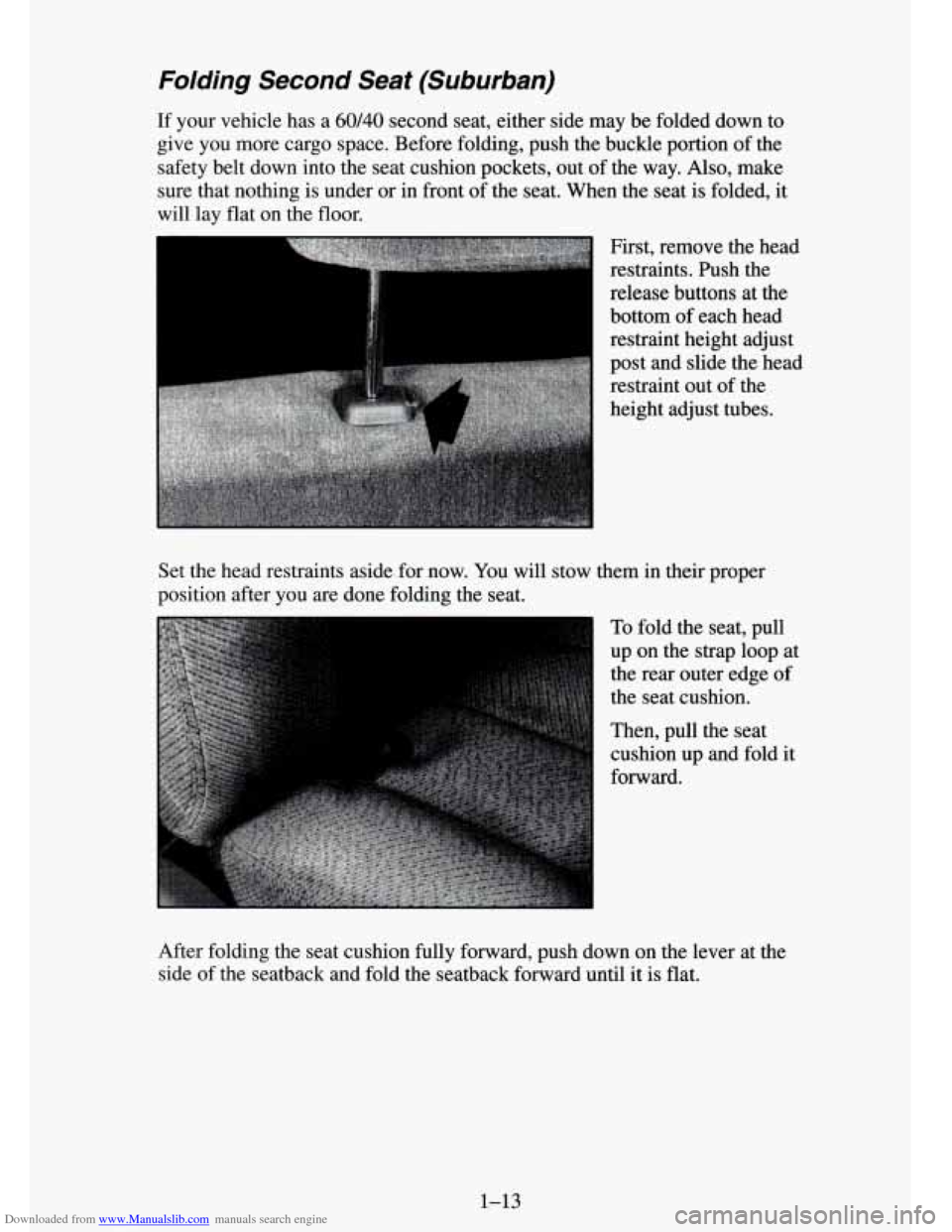
Downloaded from www.Manualslib.com manuals search engine Folding Second Seat (Suburban)
If your vehicle has a 60/40 second seat, either side may be folded down to
give you more cargo space. Before folding, push the buckle portion of the
safety belt down into the seat cushion pockets, out of the way. Also, make
sure that nothing is under
or in front of the seat. When the seat is folded, it
will lay flat
on the floor.
First, remove the head
restraints. Push the
release buttons at the
bottom of each head
restraint height adjust
post and slide the head
restraint out of the
height adjust tubes.
Set the head restraints aside for now. You will stow them in their proper
position after you are done folding the seat.
To fold the seat, pull
up on the strap loop at
the rear outer edge of
the seat cushion.
Then, pull the seat
cushion up and fold it
forward.
After folding the seat cushion fully forward, push down on the lever at the
side of the seatback and fold the seatback forward until it is flat.
1-13
Page 38 of 486
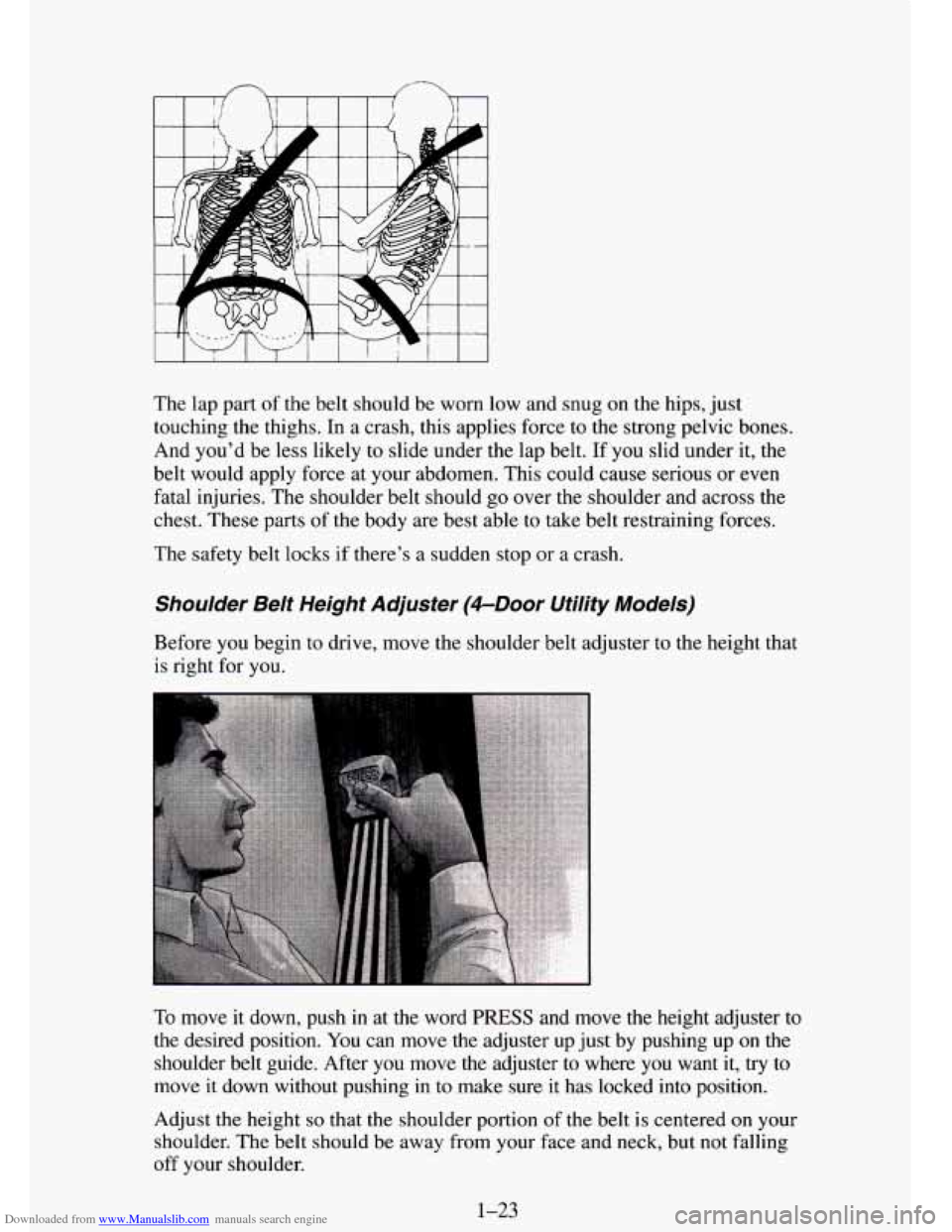
Downloaded from www.Manualslib.com manuals search engine The lap part of the belt should be worn low and snug on the hips, just
touching the thighs. In a crash, this applies force to the strong pelvic bones.
And you’d be less likely to slide under the lap belt. If you slid under it, the
belt would apply force
at your abdomen. This could cause serious or even
fatal injuries. The shoulder belt should go over the shoulder and across the
chest. These parts of
the body are best able to take belt restraining forces.
The safety belt locks if there’s a sudden stop
or a crash.
Shoulder Belt Height Adjuster (&Door Utility Models)
Before you begin to drive, move the shoulder belt adjuster to the height that
is right for you.
To move it down, push in at the word
PRESS and move the height adjuster to
the desired position. You can move the adjuster up just
by pushing up on the
shoulder belt guide. After you move the adjuster to where you want it,
try to
move it down without pushing
in to make sure it has locked into position.
Adjust the height
so that the shoulder portion of the belt is centered on your
shoulder. The belt should be away from your face and neck, but not falling
off your shoulder.
1-23
Page 48 of 486
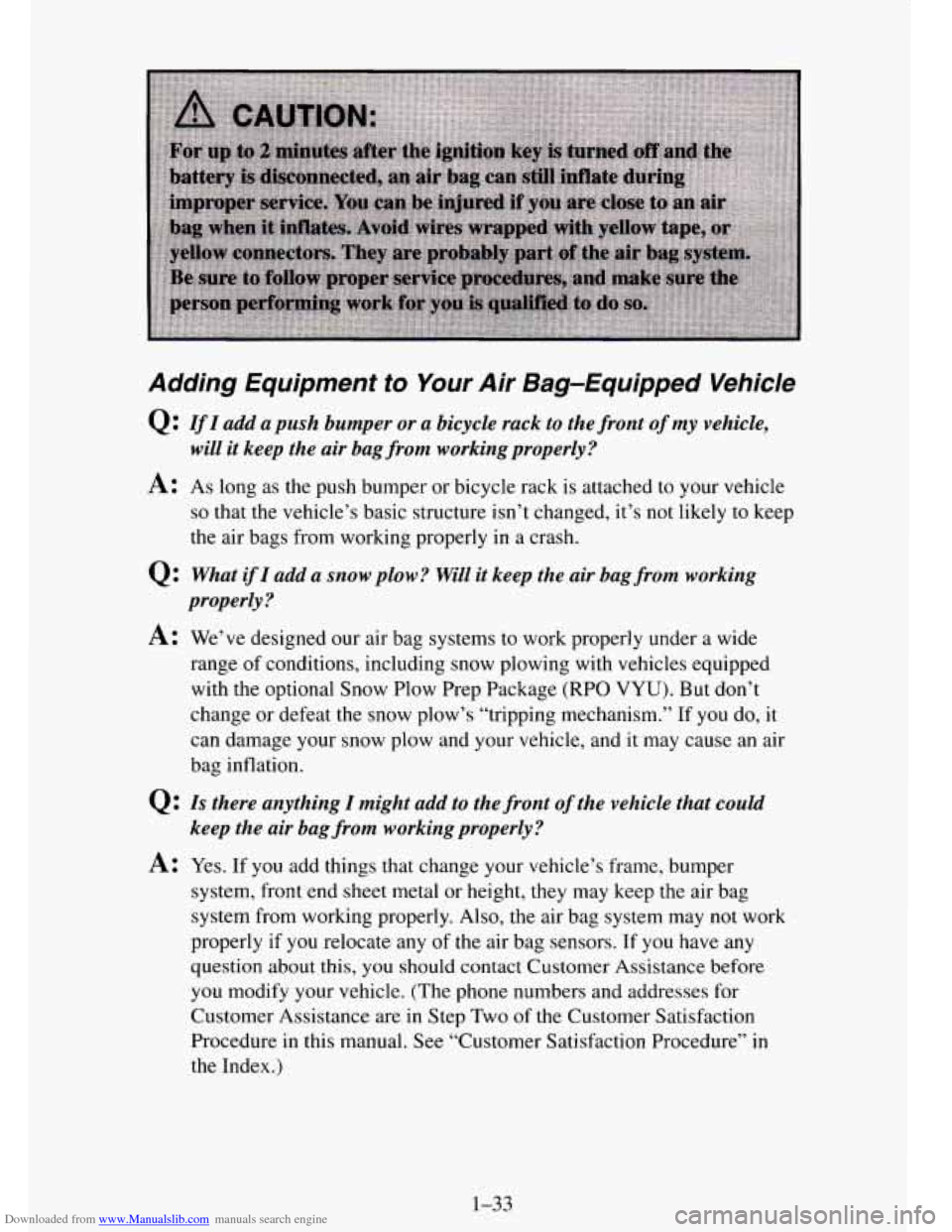
Downloaded from www.Manualslib.com manuals search engine Adding Equipment to Your Air Bag-Equipped Vehicle
Q: IfI add a push bumper or a bicycle rack to the front of my vehicle,
A: As long as the push bumper or bicycle rack is attached to your vehicle
will it keep the air bag from working properly?
so that the vehicle’s basic structure isn’t changed, it’s not likely to keep
the air bags from working properly
in a crash.
Q: What if I add a snow plow? Will it keep the air bag from working
properly?
A: We’ve designed our air bag systems to work properly under a wide
range
of conditions, including snow plowing with vehicles equipped
with the optional Snow Plow Prep Package (RPO VYU). But don’t
change or defeat the snow plow’s “tripping mechanism.”
If you do, it
can damage your snow plow and your vehicle, and it may cause an air
bag inflation.
Q: Is there anything I might add to the front of the vehicle that could
A: Yes. If you add things that change your vehicle’s frame, bumper
keep the air bag from working properly?
system, front end sheet metal or height, they may keep the air bag
system from working properly. Also, the air bag system may
not work
properly
if you relocate any of the air bag sensors. If you have any
question about this,
you should contact Customer Assistance before
you modify your vehicle. (The phone numbers and addresses for
Customer Assistance are in Step Two
of the Customer Satisfaction
Procedure in this manual. See “Customer Satisfaction Procedure”
in
the Index.)
1-33
Page 54 of 486
Downloaded from www.Manualslib.com manuals search engine Shoulder Belt Height Adjuster (4-Door Utility Models)
Move the shoulder belt adjuster to the height that is right for you.
To move it down, push in at the word PRESS and move the height adjuster
to the desired position.
You can move the adjuster up just by pushing up on
the shoulder belt guide. After you move the adjuster to where you want it,
try to move it down without pushing in to make sure it has locked into
position.
Adjust the height
so that the shoulder portion of the belt is centered on your
shoulder. The belt should be away from your face and neck, but not falling
off your shoulder.
To unlatch the belt,
just push the button
on
the buckle.
1-39
Page 100 of 486
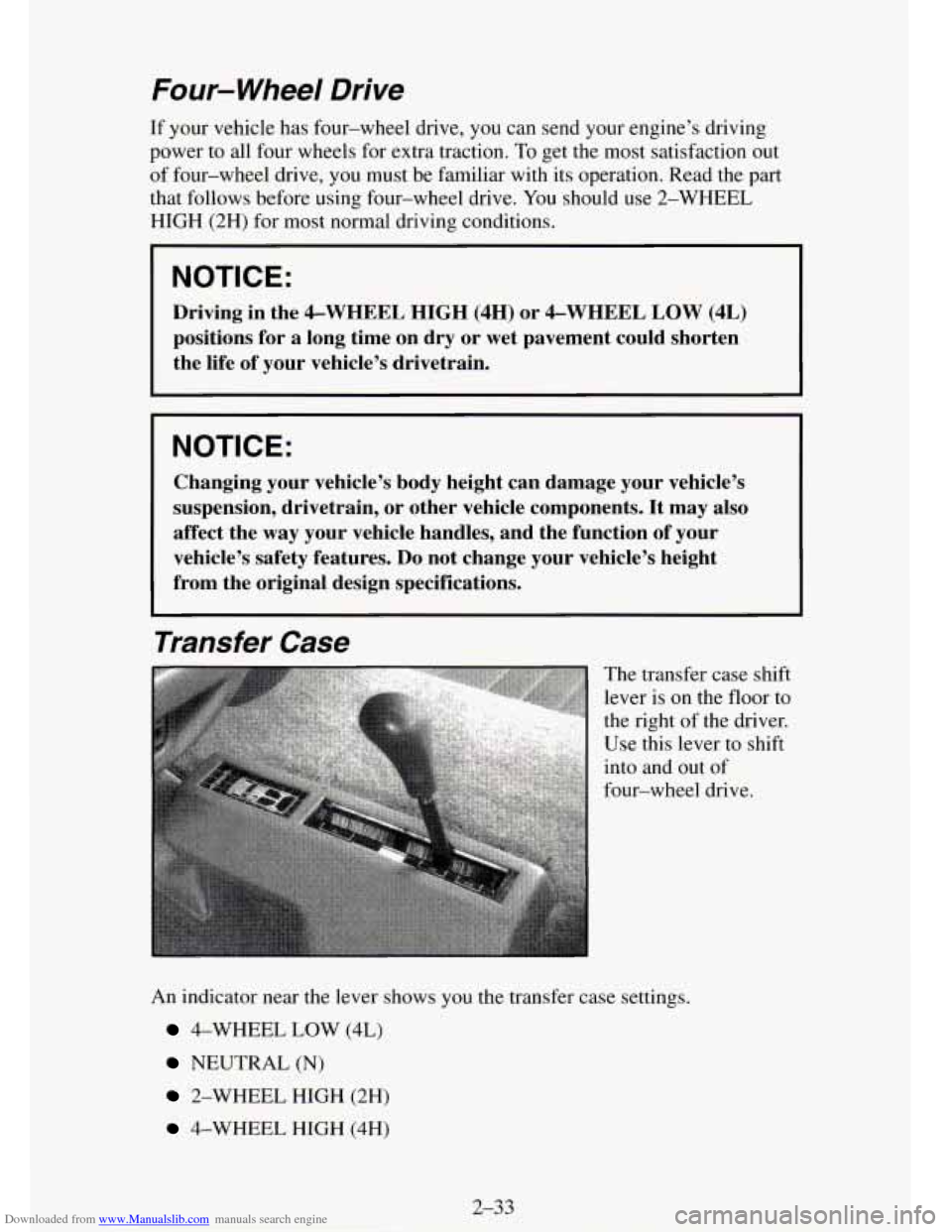
Downloaded from www.Manualslib.com manuals search engine Four- Wheel Drive
If your vehicle has four-wheel drive, you can send your engine’s driving
power to all four wheels for extra traction.
To get the most satisfaction out
of four-wheel drive, you must be familiar with its operation. Read the part
that follows before using four-wheel drive. You should use 2-WHEEL
HIGH (2H) for most normal driving conditions.
NOTICE:
Driving in the 4-WHEEL HIGH (4H) or &WHEEL LOW (4L)
positions for a long time on dry or wet pavement could shorten
the life of your vehicle’s drivetrain.
I NOTICE:
Changing your vehicle’s body height can damage your vehicle’s
suspension, drivetrain, or other vehicle components.
It may also
affect the way your vehicle handles, and the function of your
vehicle’s safety features. Do not change your vehicle’s height
from the original design specifications.
Transfer Case
The transfer case shift
lever is on the floor to
the right of the driver.
Use this lever to shift
into and out
of
four-wheel drive.
An indicator near the lever shows you the transfer case settings.
4-WHEEL LOW (4L)
NEUTRAL (N)
2-WHEEL HIGH (2H)
4-WHEEL HIGH (4H)
2-33
Page 320 of 486
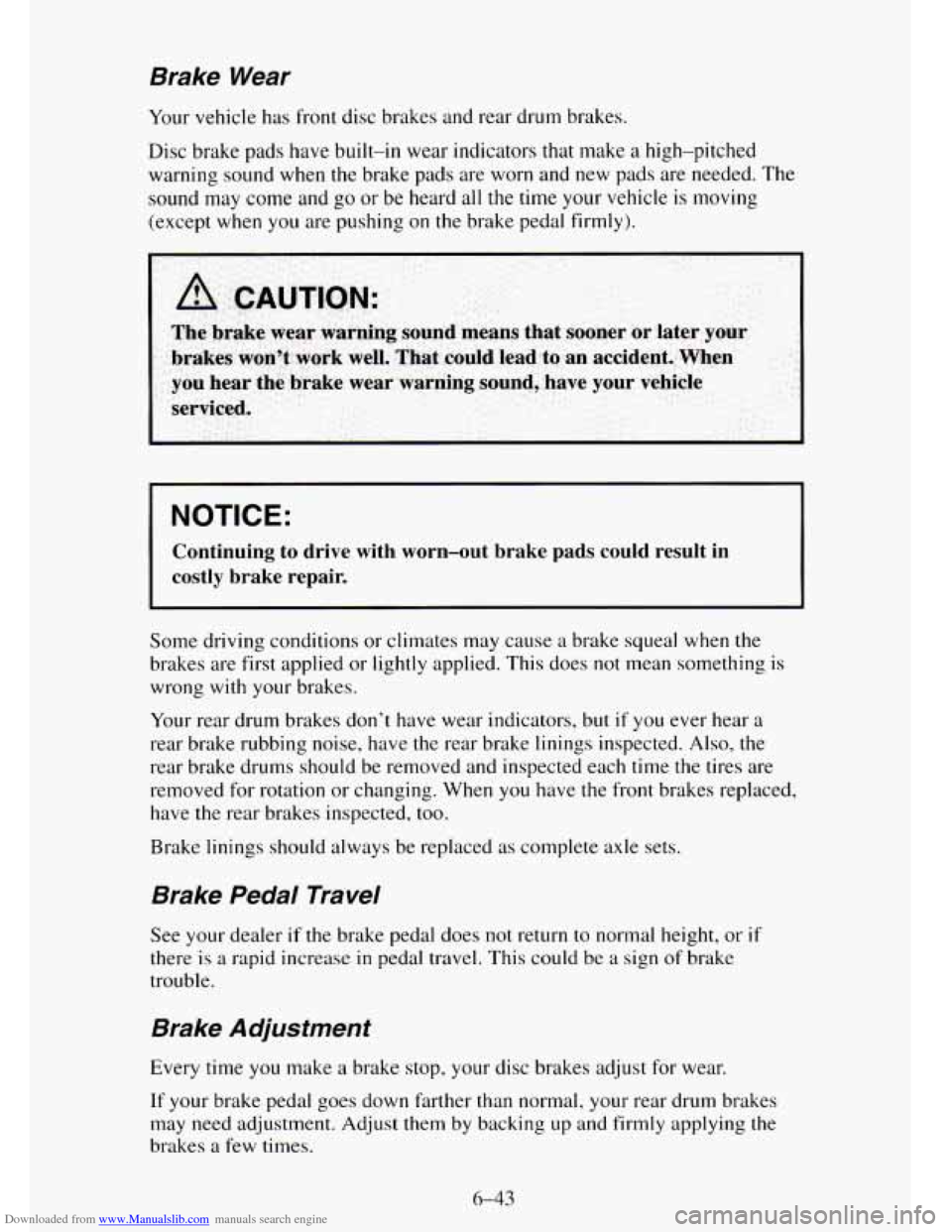
Downloaded from www.Manualslib.com manuals search engine Brake Wear
Your vehicle has front disc brakes and rear drum brakes.
Disc brake pads
have built-in wear indicators that make a high-pitched
warning sound when the brake pads are worn and new pads are needed. The
sound may come and
go or be heard all the time your vehicle is moving
(except when you are pushing on the brake pedal firmly).
I NOTICE:
Continuing to drive with worn-out brake pads could result in
costly brake repair.
Some driving conditions or climates may cause a brake squeal when the
brakes are first applied or lightly applied. This does not mean something is
wrong with your brakes.
Your rear drum brakes don’t have wear indicators, but
if you ever hear a
rear brake rubbing noise, have the rear brake linings inspected. Also, the
rear brake drums should be removed and inspected each time the tires are
removed for rotation or changing. When
you have the front brakes replaced,
have
the rear brakes inspected, too.
Brake linings should always be replaced as complete axle sets.
Brake Pedal Travel
See your dealer if the brake pedal does not return to normal height, or if
there
is a rapid increase in pedal travel. This could be a sign of brake
trouble.
Brake Adjustment
Every time you make a brake stop, your disc brakes adjust for wear.
If your brake pedal goes down farther than normal, your rear drum brakes
may need adjustment. Adjust them by backing up and firmly applying the
brakes a few times.
6-43